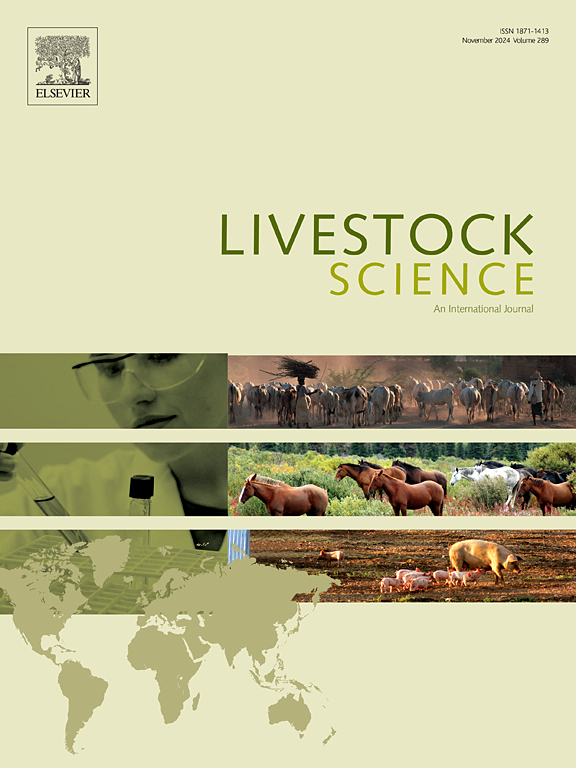饲喂不同粗蛋白质含量饲粮的生长-育肥猪胰酶活性和肠道形态存在差异
IF 1.8
3区 农林科学
Q2 AGRICULTURE, DAIRY & ANIMAL SCIENCE
引用次数: 0
摘要
在生长-肥育阶段,降低猪的饲料转化率(FCR)对于提高猪群的经济效益至关重要,同时也可以减少营养物质的排泄和碳足迹。因此,了解影响FCR的生物因素是很重要的。在本试验中,60头生长-育肥猪被分为3个饲粮处理,分别饲喂低LCP;148 g CP/kg),标准(SCP;152 g CP/kg),或高(HCP;在30 ~ 115 kg体重范围内饲喂158 g CP/kg粗蛋白质(CP)饲粮,试验期10周。分别测定采食量和体重。在每种饲粮中,根据猪在最后4周的FCR分为最高30%(高FCR)、中等40%和最低30%(低FCR)。在20周龄时对被分类为低和高FCR的猪实施安乐死,并收集胰腺以及小肠和大肠样本,随后进行酶活性和形态特征分析。与高饲料效率猪相比,低饲料效率猪的酶活性差异包括胰蛋白酶活性较低(P = 0.05),丙氨酸转氨酶活性较高(P = 0.02)。在天冬氨酸转氨酶(P = 0.06)和乳酸脱氢酶(P = 0.08)活性方面,饲粮与饲料饲料有互作的趋势。此外,低脂肪比猪和高脂肪比猪的肠道形态也存在差异,低脂肪比猪的盲肠肌层更薄(P = 0.04),远端SI绒毛高度更短(P = 0.07)。由此可见,生长-育肥猪的饲料效率水平与其胰腺酶活性之间可能存在一定的联系。本文章由计算机程序翻译,如有差异,请以英文原文为准。
Grower-finisher gilts with high and low feed conversion fed diets with varied crude protein content differ in pancreatic enzyme activity and gut morphology
Reducing the feed conversion ratio (FCR) in pigs during the grower-finisher phase is crucial for improving the herd's economy, while also reducing nutrient excretion and carbon footprint. Therefore, understanding the biological factors contributing to FCR is important. In this study, sixty grower-finisher gilts were divided between three dietary treatments and fed a low (LCP; 148 g CP/kg), standard (SCP; 152 g CP/kg), or high (HCP; 158 g CP/kg) crude protein (CP) diet from 30 to 115 kg of body weight, for a period of 10 weeks. Feed intake and weight were measured individually. Within each diet, pigs were categorized based on their FCR during the final four growing weeks as the 30 % highest (high FCR), medium 40 %, and 30 % lowest (low FCR). The pigs categorized as low and high FCR were euthanized at 20 weeks of age where pancreatic as well as small (SI) and large intestinal samples were collected, and subsequently subjected to an analysis of enzyme activity and morphological characteristics. Differences with respect to enzyme activity in low compared with high FCR pigs included lower (P = 0.05) trypsin activity, and greater (P = 0.02) alanine aminotransferase activity. There was a tendency for a diet and FCR interaction with respect to aspartate aminotransferase (P = 0.06) and lactate dehydrogenase (P = 0.08) activity. In addition, differences in gut morphology between low and high FCR pigs were found, where a thinner (P = 0.04) caecal muscular layer and a tendency (P = 0.07) for shorter distal SI villous height were observed in the low FCR pigs. In conclusion, the results indicate a possible link between the level of feed efficiency of grower-finisher gilts and their pancreatic enzyme activity.
求助全文
通过发布文献求助,成功后即可免费获取论文全文。
去求助
来源期刊

Livestock Science
农林科学-奶制品与动物科学
CiteScore
4.30
自引率
5.60%
发文量
237
审稿时长
3 months
期刊介绍:
Livestock Science promotes the sound development of the livestock sector by publishing original, peer-reviewed research and review articles covering all aspects of this broad field. The journal welcomes submissions on the avant-garde areas of animal genetics, breeding, growth, reproduction, nutrition, physiology, and behaviour in addition to genetic resources, welfare, ethics, health, management and production systems. The high-quality content of this journal reflects the truly international nature of this broad area of research.
 求助内容:
求助内容: 应助结果提醒方式:
应助结果提醒方式:


